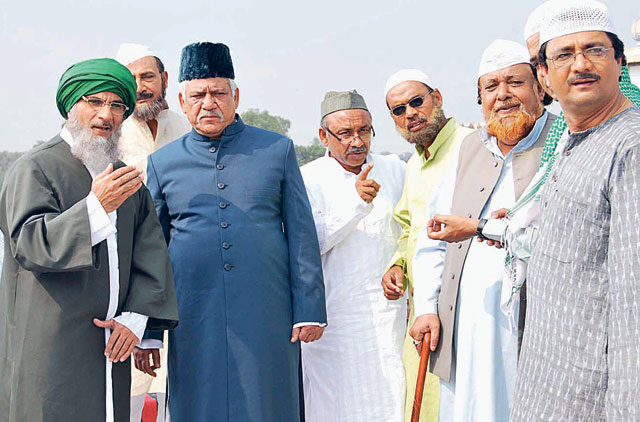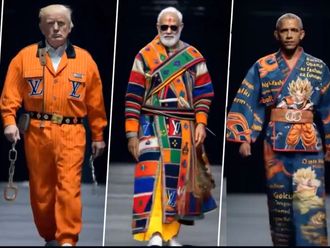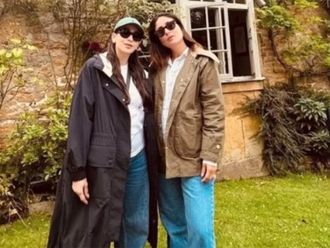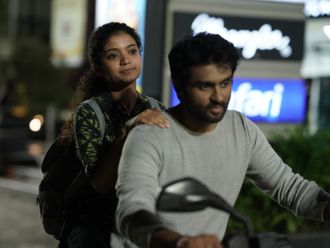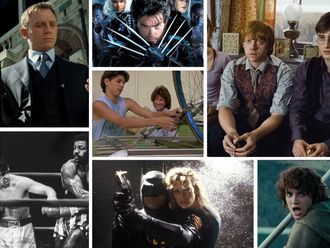Amit Rai busts stereotypes. The 33-year-old director, whose debut film Road to Sangam garnered 13 international awards, could be your friendly next-door neighbour. Success sits lightly on his head.
In Chennai recently to receive the Gollapudi Srinivas Award for Best Debutant Director (see box), Rai talks about the journey, the road that took him to international acclaim, the hurdles he had to cross and the joy of sharing his success with his family, especially his father.
The idea for Road to Sangam came about when he saw a news item on NDTV. "It was in 2006. I remember it was the festival of Holi and I was watching the news, when the last bit caught my attention," Rai recalled.
The news centred on a vehicle kept at the Allahabad Museum which had carried Mahatma Gandhi's ashes to the Sangam in 1948. The vehicle had been repaired by one Husmatullah.
"I couldn't help thinking about this man long afterwards. I wondered how he must be feeling about the entire thing. I have often thought about the Muslims who decided to stay back in India after partition. My film is about a Muslim's perspective," said the director, who has experience in Marathi theatre.
Lost in the crowd
When Rai started writing the script, he could not recall the mechanic's name.
"I gave him a fictitious name in my script, Mohammad Hafeez, which is played by Paresh Rawal."
Rai travelled to Allahabad in search of the mechanic. "The staff members at the Allahabad Museum were far from helpful," he said. "Strangely, nowhere in the pamphlets on the restored vehicle is the name of Husmatullah mentioned."
On the last day of his stay in Allahabad, Rai found Husmatullah.
"I met him — a 69-year-old and a very casual person. He had no issues when I told him that I wanted to make a film inspired by him," Rai said.
"‘You can do anything,' he told me. He allowed us to shoot at his workshop and gave us technical inputs on the engine."
So is Husmatullah similar to Mohammad Hafeez?
Rai smiled and said: "He is far better than the character in the film. A philanthropist and a hard-working person, he has struggled to sustain his family. Yes, I did model some aspects of Mohammad Hafeez's character on him, such as his hairstyle and mannerisms."
And did Rawal meet him?
"No. Paresh deliberately avoided him, since he did not want the character to be a caricature of Husmatullah. He told me: ‘If you give me some idea, I will do it [the role] my way.'"
Rai, who has worked with directors Anurag Basu and Anurag Kashyap, said finance was the main stumbling block.
"I took the script to many production houses. Everyone was keen on doing the film but in their own way. I did not want to compromise on the location or the characters," Rai said.
"I was keen on shooting the film in Allahabad. People told me I would not be able to shoot there, as it is a politically active state with a diverse culture."
The film, produced by Amit Chedda, was shot in Rani Mandi, a Muslim area. Carrying generators and wires through old, narrow lanes was an arduous task.
"The residents went out of their way to help me. Some allowed me to shoot in their houses — Paresh's house in the film and Om Puri's haveli — at a nominal cost."
To lend credibility to the shots, Rai included the Muslim residents in the crowd scenes. Casting was easy once the main characters had been finalised.
"I am a fan of Om Puri and Paresh Rawal. I felt only they could do justice to the roles.
"I admire Pawan Malhotra. I have watched his work since his Nukkad days. I told him about the character of the maulana when I was speaking to him over the phone. I played it up a bit, telling him it was an important role. I was sure he would say yes and when I went to met him, I carried the beard his character would sport with me. Seeing the beard, a surprised Pawan asked: ‘The beard is meant for an older person.' When we tried it in the bathroom, Pawan said: ‘It is looking good.'"
Rai laughed and said: "He shaved off his moustache for the role, for the first time in 25 years, and sported a new one to match the beard."
If many found it difficult to believe Malhotra had accepted the role, there were others who doubted the voice of the character was his. Malhotra had modulated his voice into a squeaky tone for the role.
The rest of the cast were mostly stage actors from Allahabad.
Tushaar Gandhi makes a guest appearance in the film, in which he plays himself. As the great grandson of Mahatma Gandhi, he carries the ashes and immerses it into the Sangam.
"Tushaar was spellbound when I narrated the script to him," Rai said.
"He suggested we include a qawwali in the film. He also shared his experience of filing a petition to procure the ashes of his great grandfather which were stored in a bank locker in Orissa. His eyes welled up as he narrated the bit about the authorities asking him to take the urn through the back door. Tushaar was aghast. ‘Are the ashes that of a terrorist?'"
The urn came in a sealed box. "I made a similar box for the film. Tushaar is a gem of a person. He was completely involved while shooting. He would keep the box to himself all the time."
The climax scene was shot for more then 45 minutes, with candid shots of people watching from rooftops and peering out of windows to see Bapu's van roll through the streets.
About the scene in which Gandhi immerses the ashes of his great grandfather into the Sangam, Rai said: "The waters were not still and the boat carrying Tushaar was swaying. On top of that, it was evening and the light was fading. We had to do it quickly. We got three people to hold the boat still. The shot was canned."
The film received the Best First Film Director's award at the International Festival in South Africa in 2009. At the Los Angeles Reel Film Fest last year, it won awards for Best Original Score and Best Production Design. It won the Best Feature Film award at the Radar Hamburg Fest, Germany, and Best Narrative Feature at White Sands fest in New Mexico. At Cannes, it got a standing ovation. Apart from the Viewers Choice award at the MAMI fest in Mumbai and the Gollapudi award, the film remains little-known in India.
Speaking about film international film festivals, Rai said: "In South Africa, London and Germany, I was surprised to see that people seemed to know more about Mahatma Gandhi than us. Many cried after watching the film. A German Sanskrit teacher came up to me and said: ‘I know this man through books but learnt about his charisma through Richard Attenbourough's Gandhi. This is the best film on Gandhi after that."
"Gandhiji is neglected here," Rai said. "We take him for granted."
Impressed by the film, a Muslim foundation in the US has invited Rai to deliver talks on terrorism and secularism this month. The Kerala government has waived tax on the film. In the story, the humble postcard is given importance. This prompted the Indian postal department to promote the film for a while. Although the UP government claims to encourage shooting of films in their state with a cash incentive of Rs2 million, Rai is yet to receive it.
The icing on the cake, he said, was watching the film with his father at the Mumbai festival. "I made him sit in the second row but he was so nervous that he preferred the last row. After the show, I found him crying in the parking lot. My mother later mentioned that after returning home, he constantly talked about me and the appreciation I got."
Until then, Rai's father had been unhappy with his fascination for films. He wanted his son to be an engineer or a doctor.
"He had stopped talking to me," said this science graduate with a masters in computers. "He would say: ‘You are not going to achieve anything through films. No one from outside the industry succeeds.'"
Ironically, it was his father who led him to films.
On a nostalgic trip, Rai recalled: "It all began because someone who had borrowed money from my father could not return the loan. Instead, on his return from Dubai, he gave him a VCR. My father purchased a television set and opened a video-rental store. People hired them for occasions. I used to carry the television set and my younger brother would carry the VCR."
He would also watch innumerable films with the customers, which fed his passion for films. "I yearned to become a director but did not have the courage to tell my father. He was a strict man. I somehow convinced my father and joined the Centre for Performing Arts, Pune University, for MA dramatics."
After stepping into Marathi experimental theatre and conducting workshops, Rai took the celluloid road.
His next script is about a man who devotes his life to the welfare of tigers and the bond he shares with a tigress.
Road to Sangam
The film opens with the discovery of Mahatma Gandhi's ashes, stored in a bank vault. His great grandson, Tushaar Gandhi, wants to immerse the ashes at the Sangam in Allahabad.
He wants to carry it in the same truck that had transported his great grandfather's ashes in 1948, but it is now a broken-down vehicle.
Husmatullah (Paresh Rawal), a devout Muslim and a skilled motor mechanic in Allahabad, is entrusted with the job. An explosion in the town results in the arrest of several Muslims on grounds of suspicion. One of them dies.
As a mark of protest, the Muslim community decides to close shop until the issue is resolved by the authorities. Husmatullah is now caught in a quandary. On the one hand is his commitment to work and on the other, loyalty to his community. When he chooses to honour his commitment, putting his love for the country and the Father of the Nation first, he faces the wrath of his people, including that of his close friends.
Standing by him are his Hindu friend, Dr Banerjee (Javed Shaikh), his wife (Swati Chitnis) and his son (Vijay Mishra). The film is not as much about Gandhi as it is about his ideologies. How Husmatullah wins his community over and honours his commitment forms the crux of ‘Road to Sangam'.
Unlike ‘Lage Raho Munna Bhai', which tried to propagate Gandhigiri in typical Bollywood style, Amit Rai's film sends across the message beautifully — he portrays Muslims as good, honest people.
The dialogues penned by Rai are the film's strength. When Husmatullah tells his people "A true Musalman hurts no one with his words and actions", you want to cheer him.
In another context, he says: "Allah does not differentiate between man and man." You want to believe him when he says: "‘Pyar se sab kuch mumkeen ho jata hai' [Love makes everything possible]."
Cinematography and music are the other plus points. Paresh Rawal carries the film on his shoulders. Supporting him are Om Puri as Mohammad Kasuri, a much-feared leader, and Pawan Malhotra, as Maulana Qureshi, a man with extremist views.
Amit Rai has woven together fact and fiction in an entertaining manner, making ‘Road to Sangam' a must-watch for everyone.
Mythily Ramachandran is an independent writer based in Chennai.


